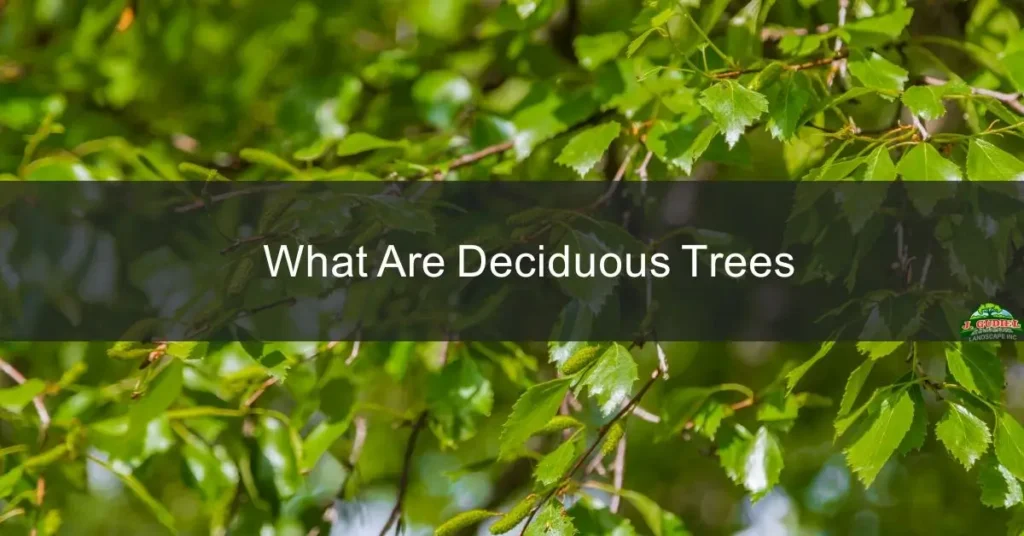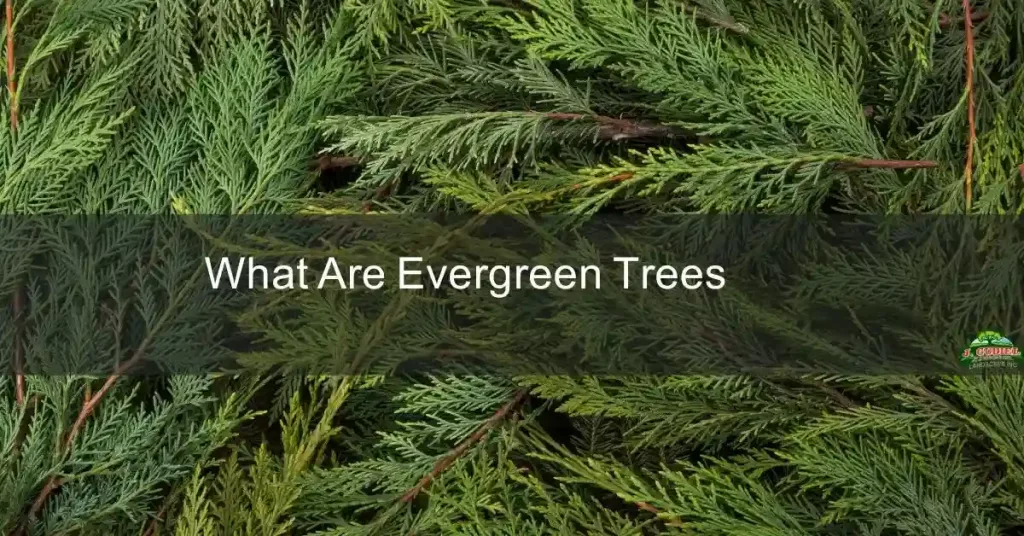When we look at trees, we can notice two main types: deciduous and evergreen. They may seem similar, but they’re actually quite different. Deciduous trees lose their leaves in the fall, while evergreen trees keep their leaves all year round. These differences affect how they adapt to the environment and their role in nature. Let’s explore the simple distinctions between deciduous and evergreen trees to appreciate their unique characteristics and importance in the natural world.
Whether you’re selecting trees or adding landscape boulders, both enhance outdoor spaces. Check out our guide on landscape boulder cost to plan your budget.
What Are Deciduous Trees

Deciduous trees are those that drop all their leaves in late fall and grow new ones in early spring when they wake up from dormancy. You can easily tell them apart in early fall because their leaves start changing colors and eventually fall off by the start of winter.
Here’s something cool about this: When the leaves fall, they make a cozy blanket around the tree, keeping its roots warm in winter. Plus, as the leaves break down, they give the soil and the tree important nutrients, helping it stay healthy.
Some people’s deciduous trees for parks, roadways, and landscaping are poplar, Aspen, Maple, and of course, the Red Maple tree. Every species is beautiful in the spring and summer, but when autumn comes, the colorful amazement inspiring. People travel hundreds of miles to see the changing of the leaves in large areas of deciduous forests.
Types of Deciduous Trees
Here are some popular types of deciduous trees.
- Oak
- Birch
- willow
- aspen
- beech
- walnut
- maple
- And 100s more
Examples of Deciduous Trees
Some examples of deciduous trees
Oak
There are more then 400 species of oak trees including quercous which comes with trees and shrubs. Some of more basic species of oak trees are black, English, white, red and bur. Asian oak species include Mongolian, Oriental, Japanese, daimyo and sawtooth. Oak trees have big, flat leaves with edges that have little bumps or teeth on them in some types of oak. Acorns are like nuts that come from oak trees. People often use oak wood to build things like houses, furniture, and floors because it’s really strong and lasts a long time.
Birch
Birch trees have smooth white and black skin, they are used for timber and ornamental purposes. There are at least 40 species of birch trees. Common species are aper, river, gray, white and yellow. Two Japanese species are monarch and cherry birch. Birch leaves are egg-shaped or sometimes triangular and have sharp edges. birch leaves turn yellow in fall season. Birch is often used to make furniture, floors, walls, borders, cabinets, and plywood. But in some regions people use birch skin for making canoes, roofs, and shoes.
What Are Evergreen Trees

Evergreen trees remain green through all the seasons. While deciduous trees loss all of their foliage in the fall, Evergreen trees always grow new leaves or needles to replace the ones they lose.
Evergreens gradually replace their leaves or needles, the garbage having different types of elements can create an environment for soil which can become higher in acidity and lower in nitrogen, when evergreen trees continuously replace what they lose, and they provide year-round shelter, it creates perfect conditions for new evergreen growth to thrive.
Types of Evergreens Trees
Here are some popular types of Evergreen trees.
- Eastern white pines
- Japanese umbrella pine
- Longleaf pine
- Aleppo pine
- Scots pine
- Yaupon holly
- Southern magnolia
- Colorado blue spruce
Examples Of Evergreen Trees
Some examples of Evergreen trees
Eastern white pine
Eastern white pine is a big evergreen tree found in Eastern North America. It has soft needles and a straight trunk. People like it for its tall, straight wood. Animals live in it too. Long ago, Native Americans and settlers used it for building things. Now, it’s often used in gardens and forests to grow quickly and look nice.
Aleppo pine
The Aleppo pine is a type of tree that grows in the Mediterranean. It has long needles and rough bark. It’s good at growing in hot and dry places with bad soil. People use it for landscaping and sometimes for wood. But in some places, it’s seen as a problem because it spreads too much.
Difference Between Deciduous and Evergreen
Deciduous trees lose all their leaves once a year, usually in the fall, to save water and energy during winter or dry seasons. In contrast, evergreen trees keep their leaves all year, dropping them slowly over time. Deciduous trees have broad, flat leaves that change color in autumn before falling, while evergreen trees usually have needle-like or waxy leaves, which hold water better and survive in tough weather. Since deciduous trees can only make food when they have leaves, they stop growing in winter, but evergreen trees make food all year and keep growing.
Deciduous trees grow in places with four seasons, like oak, maple, and birch, while evergreen trees, like pine, spruce, and fir, grow in cold, dry, or tropical places. Deciduous trees bring beautiful fall colors, while evergreen trees provide greenery and shelter for animals all year long.
To maintain a healthy landscape, many homeowners rely on automated irrigation systems for efficient and consistent watering. These systems help conserve water while keeping trees and plants thriving with minimal effort.
Characteristics of Deciduous trees
Here are some characteristics of deciduous trees.
Deciduous trees are trees that lose their leaves every year, usually in the fall. They do this to save water and energy during the cold winter or dry seasons. Their leaves are broad and flat, which helps them absorb sunlight for photosynthesis, but also makes them sensitive to weather changes. In autumn, the leaves change color before falling off because the tree stops making chlorophyll (the green pigment). During winter, the tree rests and stops growing, then in spring, new leaves grow back. Many deciduous trees also produce flowers and fruits, which help them spread seeds and provide food for animals. Their wood is strong and useful for making furniture and buildings. Some common deciduous trees are oak, maple, birch, beech, and cherry. These trees are mostly found in places with four seasons, making forests look colorful in autumn.
Characteristics Of Evergreen Trees
Here are some characteristics of evergreen trees:
Evergreen trees are trees that keep their leaves all year round, even in winter. Unlike deciduous trees, they do not lose all their leaves at once but shed them gradually while growing new ones. Their leaves are often needle-like or waxy, which helps them save water and survive in cold or dry climates. These trees can photosynthesize year-round, giving them a steady energy supply. Evergreen trees also produce cones or flowers, depending on the species, to grow seeds. Their wood is strong and durable, making it useful for construction and furniture. Some common evergreen trees include pine, spruce, fir, cedar, and holly. They are mostly found in cold, mountainous, or tropical areas, where they provide shelter and food for wildlife throughout the year.
Conclusion
Deciduous and evergreen trees are the two main types. Deciduous trees drop their leaves at certain times, while evergreen trees keep their leaves all the time. That’s the big difference. Also, deciduous trees are more sensitive to weather changes like temperature and rain, but they can handle cold and dry weather okay. So, the main thing to remember is that deciduous trees lose their leaves, while evergreens don’t.
For more exciting content, follow us on Yelp, Facebook, and Instagram.
FAQs
Q1: Types of evergreen trees for landscaping
A: Some common types of evergreen trees used in landscaping are pine trees, which have long needles and cones, spruce trees, known for their pointed needles and distinctive cones, and cedar trees, with their aromatic foliage and attractive cones. These evergreens provide year-round greenery and often serve as focal points or privacy screens in gardens and landscapes.
Q2: Definition of a deciduous tree
A: Deciduous trees are characterized by their annual leaf-shedding cycle, which occurs during the fall season. This natural process enables them to conserve energy and endure fluctuating weather patterns throughout the year, as they prepare to grow new leaves in the following spring.
Q3: How are deciduous and evergreen trees helpful to nature differently?
A: Deciduous trees help recycle nutrients when they lose their leaves, while evergreens provide homes and food for animals all year.
Q4: Which trees are usually chosen for gardens, and why?
A: People often pick evergreen trees for gardens because they stay green all year, making them great for privacy and adding beauty. But some also like deciduous trees for their colorful leaves in autumn.

